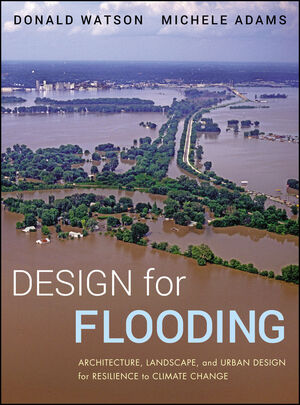Design for Flooding: Architecture, Landscape, and Urban Design for Resilience to Climate ChangeISBN: 978-0-470-47564-5
Hardcover
336 pages
November 2010
 |
||||||
Connect with Wiley Publicity
Since Hurricane Katrina and the flooding that followed that left 80 percent of New Orleans underwater, flooding has been in the headlines. Extreme weather events such as Hurricane Katrina in 2005, Hurricane Ike in 2008, coastal flooding, as well as flooding along the Mississippi and Red Rivers have yielded invaluable lessons regarding land use and development near water. These lessons demonstrate that life threat and extensive damage can be avoided and mitigated by design for resilience to extreme weather and climate change.
John Wiley & Sons is releasing DESIGN FOR FLOODING: Architecture, Landscape, and Urban Design for Resilience to Climate Change (John Wiley & Sons; December 2010; $85.00) as a guide for architects, urban planners, and engineers planning and designing for flooding, natural disasters, as well as water sustainability. The book presents the best practices and lessons to create buildings and communities that are more resilient in the face of severe weather, climate change, and the prospect of rising sea level.
Written by an architect and engineer, this book provides a comprehensive primer to planning and design to achieve sustainable water resources -- often called water security -- applicable to architecture, regional planning, storm water engineering, and landscape design. The authors focus on the management of watersheds as natural and designed hydrologic systems to optimize conservation and improvement of water as a resource. DESIGN FOR FLOODING compiles illustrated technical data for rainwater collection, storage, and management appropriate for both arid and flooding conditions. Special conditions of coastal flood hazard mitigation are included because many similar principles and techniques apply. A portfolio of award-winning designs illustrates practical and visionary projects to prepare for a resilient future, including:
- A case study of Climate's Long-term Impacts on Metro Boston (CLIMB) analyzes four alternatives to prepare for climate change
- A design charrette sponsored by The Regional Plan Association of New York illustrates creative concepts for waterfront revitalization and flood protection
- Lessons from the Netherlands, Japan, and the United States indicate the effectiveness of long-term preparedness planning combined with phased mitigation and renewal projects
- Examples include renovations and small buildings, showing how every project at any scale is a design opportunity to increase the sustainability and resilience of our communities, water, and ecosystem services
Today’s site engineering practice is dominated by engineered flood control often implemented at the expense of natural water flows and landscape solutions. DESIGN FOR FLOODING advocates for policies and innovation to implement sustainable watershed and stormwater design. Illustrating the entire range of water management practices and technical data available for design professionals seeking to integrate sustainable water conservation and green infrastructure, this is a sourcebook of practices and techniques for design and engineering professionals.
Praise for DESIGN FOR FLOODING:
"Design for Flooding defines the need and opportunity for planners, architects, landscape architects, engineers, and conservation biologists to work together to develop the mix of inland and coastal flooding solutions required for a comprehensive response to climate change."
—From the Foreword by Daniel Williams, FAIA, author of Sustainable Design: Ecology, Architecture, and Planning
"Design for Flooding should be a major tool for the design professions, for public agencies, and for civic activists, indeed for everyone who wishes to bring a genuinely 'intelligent' design for water to their communities. It is a call to action and demonstrates that we have the knowledge, the tools, and the capability to better manage the water system on which we depend."
—From the Foreword by Carol Franklin, FASLA
ABOUT THE AUTHOR:
Donald Watson, FAIA, an architect and planner, is former chair of the Yale School of Architecture Environmental Design Program, and former professor and dean of the School of Architecture, Rensselaer Polytechnic Institute. He received the 2002 ACSA Distinguished Professor Award and the 2005 AARC Haecker Leadership Award for Architectural Research. His publications include Climatic Building Design, winner in the Architecture & Urban Planning category of the American Publishers Award for Professional and Scholarly Excellence.
Michele Adams, P.E., a water resources engineer, is principal and founder of Meliora Environmental Design in Kimberton, PA. Her work encompasses environmentally sensitive site design and sustainable water resources engineering.
DESIGN FOR FLOODING
Architecture, Landscape, and Urban Design for Resilience to Climate Change
Published by John Wiley & Sons, Inc.
Publication date: December 13, 2010
$85.00; Hardcover; 336 pages; ISBN: 978-0-470-47564-5



